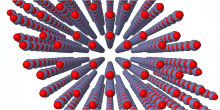
The McChasy code aids in the study of defects in semiconductors for special applications
28-12-2023
Defects in the crystal structure of semiconductors used in space and nuclear industry can have an impact on the functioning of devices built with them. A master's student from Instituto Superior Técnico in Portugal, in collaboration with NCBJ scientists, investigated defects that arise in gallium nitride when bombarded with argon. The use of the McChasy computer program developed in Świerk was a crucial aspect of the research.
Gallium nitride (GaN) is a semiconductor that enables the development of high-voltage electronics, operates at high temperatures, and can withstand various forms of radiation found in space or nuclear reactors. To induce or enhance certain device properties based on GaN, ion implantation is commonly employed. However, despite its advantages, this technique can introduce defects and stresses in the material, which can hinder proper device functioning and reduce its efficiency. The precise nature of these defects is still not fully understood.
The effects of argon ion (Ar) implantation in GaN were investigated by Luís Martins, a master's student at Instituto Superior Técnico, as part of the international collaboration between the National Centre for Nuclear Research (NCBJ) and Universidade de Lisboa. The thesis was supervised by Dr. Katharina Lorenz from the student's home institution and Dr. Przemysław Jóźwik from the Nuclear Microanalysis Laboratory at the NCBJ. Dr. Cyprian Mieszczyński, the head of the Nuclear Microanalysis Laboratory, also served on the examination committee. This study represents the second master's thesis in the Polish-Portuguese collaborative project focusing on defect research. An essential component of this joint effort is the Monte Carlo simulations performed using the McChasy program, which was developed at NCBJ in the 1990s as a tool for analyzing experimental data on ion channeling.
Ion channeling techniques are employed to study defects in crystalline materials, such as semiconductors. Defects can arise from the interaction of the material with fast ions, including those encountered in space or nuclear reactors. In a laboratory setting, accelerators can be used to impart high energy to ions, which are then directed towards the material sample. When ions collide with the sample, they can displace atoms from their normal positions, defects in the material's crystal lattice. The resulting changes can be investigated using various techniques such as scanning transmission electron microscopy (STEM), X-ray diffraction (XRD), or ion channeling (RBS/C). In ion channeling, the material is bombarded again with ions accelerated to high energy, but these ions are light, such as hydrogen or helium.
"Light ions practically do not displace atoms from their normal positions but rather scatter off them due to electrostatic repulsion," explains Dr. Przemysław Jóźwik, one of the advisors of the study. "Ions scattered backward at a defined angle (typically between 140° and 170°) reach the detector, which analyzes their energies. We can convert these energies into depth in the material where scattering occurred. If the sample is appropriately aligned, the ions penetrate the material through channels created between the atoms, hence the name 'channeling.' In such an orientation, very few ions scatter backward and are detected. However, if a defect is encountered along the ion's trajectory, the probability of scattering increases significantly. Nonetheless, the type of defect plays a crucial role. For instance, with point defects (e.g., individual displaced atoms blocking the channels), scattering occurs immediately upon encountering the defect. On the other hand, dislocations and dislocation loops (which are examples of complex defects) have the ability to bend neighboring channels, effectively disrupting the ion trajectories. However, scattering occurs deeper within the material, after bypassing the defect."
The challenge in proper interpretation of ion channeling results lies in distinguishing signals originating from different types of defects. The McChasy program assists scientists in interpreting the obtained data and characterizing various types of defects. Through simulations with McChasy-1, Luís Martins expanded the current understanding of the types of defects that arise in GaN due to argon ion bombardment. It was revealed that among the defects formed in the material, there are not only point defects but also dislocation loops. Using McChasy simulations, Martins also determined the concentration of both types of defects as a function of depth in the material and estimated the likely size of dislocation loops. "Complex defects must be taken into account, for example, when designing electronics for radiation environments, as their presence reduces electrical conductivity and impairs integrated circuits," explains Dr. Jóźwik. "Engineers of devices intended for space or nuclear reactors need to assess whether a material will be sufficiently efficient under specific conditions despite the defects that may arise during its operation."
NCBJ researchers continue to develop their software and make it available to the international research community (https://www.ncbj.gov.pl/mcchasy). The McChasy-1 program is being enhanced by incorporating new models of crystal defects. Another version of the program, McChasy-2, dedicated to complex defect structures obtained through molecular dynamics, is also being independently developed. McChasy-2, among other improvements, has the ability to read huge files with positions of billions of atoms. The results obtained through these advancements are more realistic, but using the new code is more challenging and requires significantly greater computational power.
Visualization of the atomic arrangement in gallium nitride, oriented along the [0001] direction (known as the crystal c-axis), with a visible channel formed between the atoms. McChasy-1 reads the positions of atoms in such small structures, slightly modifies them while considering thermal vibrations, and appropriately displaces them to replicate a specific type of defect. Then, helium ions are introduced into such a structure, and the program calculates the probability of ion scattering at a given angle for each atom. This procedure is repeated until a predefined depth within the crystal is reached, involving tens of thousands of helium ions. Source: NCBJ.






